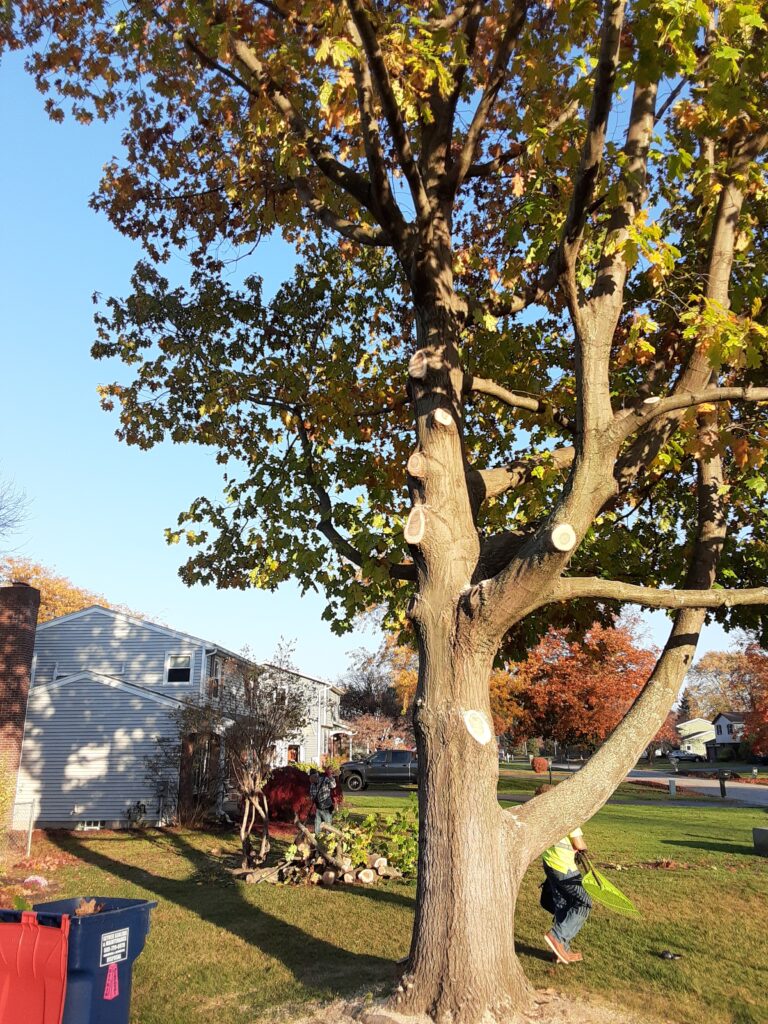TREE Pruning
About Tree Pruning

Trees can be a very valuable asset to your property. Most trees need to be pruned from time to time. There are three main acceptable methods of tree trimming: Crown Thinning, Crown Raising, and Crown Reduction. In the Webster, NY area, most trees can be pruned at any time of the year. For certain tree species, or if the tree is to be extensively trimmed, we often recommend waiting until the tree is dormant.
Crown Thinning
Crown Thinning can improve the health of your tree by removing dead, diseased, and crossing branches. This can help prevent disease from spreading in your tree. Also, removing dead branches can improve the safety of your property, as large dead branches can injure people or damage property if they are left until they fall out of the tree naturally. Crown thinning is a good time to selectively prune by removing branches that have weaker branching patterns. Branches that are growing in a U-shaped pattern are preferred over branches that have a V-shaped branching structure. The reason is that at the base of the V, (the branch union) there is often bark included, which can contain decay that will often compromise the branch, causing the branch to eventually break. Trees that have weaker wood often benefit from crown thinning, because if left un-pruned, the dense canopy combined with the weak wood can lead to a large amount of wind resistance, which can cause the branches to break. Thinning out the canopy results in less wind resistance, which can help prevent storm damage. Typically, crown thinning involves removing no more than about 1/3rd of the living branches in the crown at one time. If too many branches are removed at once, this can lead to sucker growth.
Crown Raising/Directional Pruning
Crown raising is one of the most common types of tree trimming. It is simply the removal of the lower branches of the tree. This may be done for a variety of reasons. Oftentimes, the lower branches are removed to improve the view of the yard. Another reason for crown raising is to make it easier to mow the yard without having to “duck” under branches. Crown raising can also be beneficial in removing branches that are growing over buildings. The oak tree shown above in the photo was pruned by directionally pruning away the branches that were obstructing the driveway and hanging over the house.
Crown Reduction
Some times, trees grow too tall. The overall effect may “dwarf” a house, but the homeowner may still wish to keep the tree. In this situation, one option is to perform a crown reduction. With crown reduction, the height and overall size of the tree is reduced by up 20% by trimming the taller branches back to the nearest “leader” branch that is at least 1/3rd of the size of the branch being removed. Crown reduction, while it reduces the height of the tree, differs significantly from “topping” a tree.
Why We Generally Don't "Top" Trees: The Dangers of Tree "Topping"
Tree topping is generally a dangerous practice, both for the tree and your property. Unfortunately, some unscrupulous arborists offer this service. Tree topping involves cutting the top of the tree off entirely. Typically, what follows are one of two scenarios, neither of which are good for the tree: die-back or excessive weak sprout growth. Significant dieback can following topping, and this is caused due to excessive air in the vascular system that enters at the overly-large pruning cuts, causing the vascular system to loose it’s “prime”. This is especially likely to occur if the tree is topped many feet above the ground. Alternatively, sometimes the tree at first appears to be just fine, as suckers quickly grow. However, the suckers grow extremely fast, sometimes as much as 20′ per year. Therefore, topping isn’t a viable long-term solution for reducing the height of trees.
Another consideration is that after topping, if suckers grow, the new suckers are far weaker than the original wood, and often grow in an undesirable V-shaped branching union connected to the trunk. Usually, suckers do not grow from the tip of the trunk; they grow several inches or feet lower on the trunk. This can can lead to a massive dead zone in the tree that soon becomes infected with rot, which can spread to the rest of the tree. Over time, the suckers grow and become full-sized limbs. Then there are two safety issues: the limbs have a v-shaped branch union (which is weak), and there is often decay present in the trunk to which the branches are attached. These new limbs can then snap from the trunk in a slight windstorm, causing damage to the tree, any surrounding houses or vehicles, or even to people. For these reasons, we do not provide tree topping. Instead of topping your tree, we recommend crown reduction pruning (which can reduce the height of your tree by up to one third, or in some cases, removing the tree entirely.
Why Hire Paul's Landscaping of NY, LLC
If you are looking for an Arborist in the Webster, NY area, look no further than Paul’s Landscaping of NY, LLC. We place a strong emphasis on safety by using high-quality tree climbing gear, and are fully insured with General Liability insurance and Worker’s Compensation Insurance. We also practice proper tree trimming techniques. Unlike some companies that routinely climb trees with spikes when they are pruning them (which can damage the trunk and lead to pockets of decay), at Paul’s Landscaping of NY, LLC, when possible, we minimize spike-usage by avoiding using climbing spikes when pruning. Instead, we use spikes when we are going to remove a tree.
You can count on Paul’s Landscaping of NY, LLC to provide you with a professional, dependable result. Each day, we have one focus: providing high quality services. That is the Art of Enhancing Properties.

